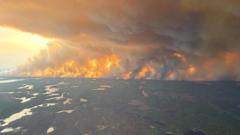Are US Lawmakers Fed Up with Canadian Wildfire Smoke Ruining Summer?

Understanding the Impact of Wildfires and Air Quality in North America
Wildfires have become an increasingly pressing issue for both Canada and the United States, especially during the summer months. The smoke from these wildfires not only affects the immediate vicinity but also drifts south, impacting air quality and the daily lives of millions of Americans. Recently, six members of Congress sent a letter to Canada's embassy expressing their constituents' concerns about the suffocating smoke and its implications on outdoor activities. This article delves into the complexities of wildfires, the response from government officials, and the broader implications for environmental health and safety.
The Current Situation: Wildfires in Canada
As of 2023, Canada has faced one of its worst wildfire seasons on record. With over 2,672 fires reported so far, the consequences have been dire. Tragically, two Canadians lost their lives, and tens of thousands have been forced to evacuate their homes. The Canadian Interagency Forest Fire Centre has noted that the worst months for wildfires this year were May and June, particularly affecting the provinces of Saskatchewan and Manitoba, where officials had to declare a state of emergency.
Wildfires are a natural occurrence in many ecosystems, including Canada’s boreal forests, where they play a vital role in the regeneration of flora. However, the frequency and intensity of these fires have been exacerbated by a variety of factors, including climate change and human activity.
Factors Contributing to Wildfire Severity
Several factors contribute to the increasing severity of wildfires in Canada:
- Climate Change: Scientists have established a link between climate change and the rising frequency of severe wildfires. Canada is warming at a rate twice that of the global average, with its Arctic regions warming three times faster. This warming has resulted in longer and more intense wildfire seasons.
- Human Activity: While natural causes such as lightning account for 93% of wildfires in Canada, human actions—including arson and poor forest management practices—can also exacerbate the situation.
- Land Management Policies: Some lawmakers have criticized the Canadian government for a supposed lack of active forest management, which they believe contributes to the severity and spread of wildfires.
Responses from Government Officials
In response to the growing concerns, six Republican lawmakers from Wisconsin and Minnesota have expressed their frustrations in a letter to Ambassador Kirsten Hillman of Canada. They highlighted the implications of the hazardous air quality caused by the drifting smoke, which limits outdoor activities during the summer— a cherished time for family and recreation.
Tom Emmer, a senior member of Congress, along with his fellow lawmakers, has called for more robust action from the Canadian government to mitigate wildfire impacts. A spokeswoman for the Canadian embassy stated that the government takes wildfire prevention seriously and is in the process of addressing the lawmakers' concerns.
The Role of Technology in Wildfire Management
The lawmakers emphasized that with the technology available today, the trend of worsening wildfires can be reversed if proactive measures are taken. Technological advancements such as satellite monitoring, predictive modeling, and enhanced firefighting equipment can contribute significantly to wildfire prevention and management. However, these technologies must be coupled with effective land management practices and strategies to be truly effective.
The Health Impact of Smoke on Americans
The smoke from Canadian wildfires has a direct impact on the air quality in the northern United States. Poor air quality due to wildfire smoke can lead to a variety of health issues, particularly for vulnerable populations, including children, the elderly, and those with pre-existing respiratory conditions. Common health impacts include:
- Respiratory Issues: Exposure to wildfire smoke can exacerbate asthma, bronchitis, and other respiratory conditions.
- Reduced Visibility: Smoke can significantly reduce visibility, creating hazardous driving conditions.
- Increased Cardiovascular Risks: Particulate matter from smoke can increase the risk of heart attacks and strokes.
As air quality deteriorates, outdoor activities become challenging and sometimes dangerous. This is particularly concerning during the summer months when families typically engage in recreational activities.
Long-term Solutions for Wildfire Management
Addressing the wildfire crisis in Canada and its implications for the U.S. requires a multifaceted approach that involves government collaboration, community engagement, and public awareness. Here are some potential long-term solutions:
1. Enhanced Forest Management Practices
Implementing active forest management practices, such as controlled burns and selective logging, can help manage the density of forests and reduce the fuel available for wildfires.
2. Investment in Technology
Investing in advanced technologies for fire detection, monitoring, and response can improve the effectiveness of wildfire management strategies. This includes the use of drones, satellite technology, and predictive analytics.
3. Public Education and Awareness
Educating the public about fire safety, preparedness, and the effects of air quality can foster community resilience. Awareness campaigns can encourage individuals to take precautions during high-risk periods.
4. Climate Action
Addressing the root causes of climate change is crucial for reducing the severity of wildfires. Governments must commit to policies that aim to reduce greenhouse gas emissions and promote sustainable practices.
Conclusion: A Call for Cooperation and Action
The recent wildfires in Canada and their subsequent impact on air quality in the United States highlight the interconnectedness of environmental issues across borders. As lawmakers call for more action and communication between governments, it’s essential for both nations to work collaboratively towards solutions that mitigate the risks associated with wildfires. The health and safety of millions depend on it.
As the summer unfolds, the lingering question remains: how can we prioritize both environmental health and community resilience in the face of increasing wildfire threats? By fostering dialogue, investing in technology, and committing to sustainable practices, we can strive for a future where outdoor summer activities remain a joyful and safe experience for all.
FAQs
What are the main causes of wildfires in Canada?
The majority of wildfires in Canada are caused by lightning strikes, accounting for approximately 93%. However, human activities, such as arson and poor forest management, also contribute significantly to the problem.
How does wildfire smoke affect health?
Wildfire smoke can lead to various health issues, including respiratory problems, reduced visibility, and increased cardiovascular risks. Vulnerable populations, such as children and the elderly, are particularly at risk.
What measures can be taken to mitigate wildfires?
Effective measures include enhanced forest management practices, investment in technology for fire detection and response, public education on fire safety, and aggressive climate action to combat climate change.
As we navigate the complexities of wildfire management and air quality, what steps do you think should be prioritized to ensure a safer environment for all? #WildfireAwareness #AirQuality #ClimateAction
Published: 2025-07-10 02:59:13 | Category: technology



